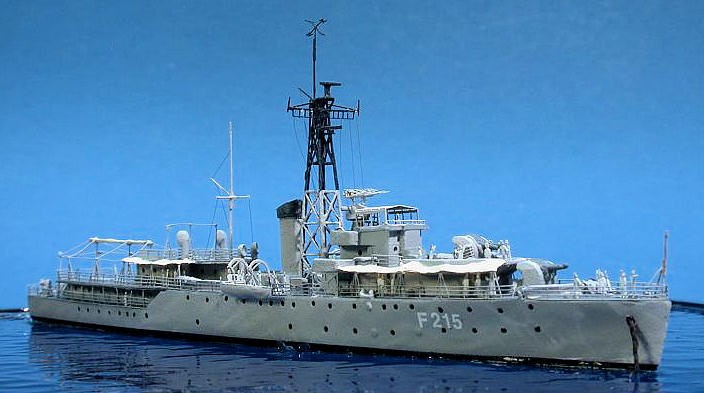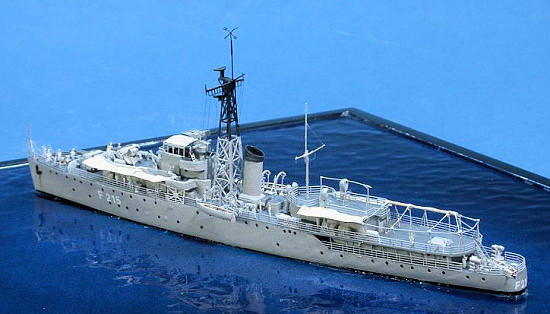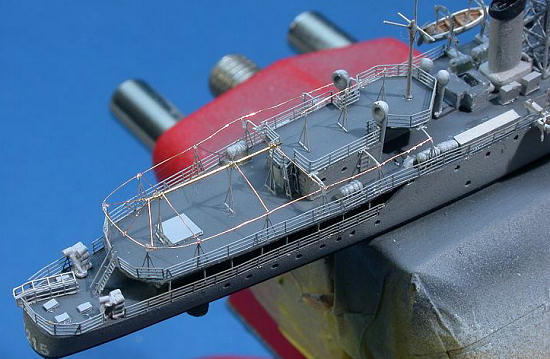
WEM 1/700 FGS F215 Graf Spee
| KIT #: | |
| PRICE: |
@ 30 |
| DECALS: | None |
| REVIEWER: | Frank Spahr |
| NOTES: | Resin kit |

| HISTORY |
When West Germany started
re-armament after WW2, a motley collection of vessels formed the nucleus
of the new Bundesmarine. These ranged from former Kriegsmarine
units, such as salvaged Type XXIII submarines or Schnellboote to
surplus allied ships. It was crucial first to train core personnel, so a
number of training ships were needed. In total, the class 138 of
Schulfregatten (training frigates) comprised seven former Royal Navy
vessels, three Hunt destroyers, one Black Swan sloop
 and
three modified Black Swan sloops. Unthinkable today, the vessels
received traditional names, including five of WW2 Kriegsmarine heavy
units (Gneisenau, Scharnhorst, Hipper, Scheer,
Graf Spee). The remaining two vessels were named Raule and
Brommy, commemorating leaders of earlier naval forces of the 17th
and 19th century.
and
three modified Black Swan sloops. Unthinkable today, the vessels
received traditional names, including five of WW2 Kriegsmarine heavy
units (Gneisenau, Scharnhorst, Hipper, Scheer,
Graf Spee). The remaining two vessels were named Raule and
Brommy, commemorating leaders of earlier naval forces of the 17th
and 19th century.
FGS Graf Spee (F 215)
was launched in 1939 as HMS Flamingo and belonged to the original
Black Swan class. She served throughout WW2 as an Atlantic escort, and
was sold to West Germany in January, 1959. She was associated with
Muerwik naval academy and was used extensively for world-wide training
cruises until 1964. She was then decommissioned; plans to convert her
into a plane guard vessel never materialized, so she was broken up in
1967. Despite her short operational service, she helped train a large
number of the new German navy´s key personnel.
The idea
Upon my last holiday in North
Germany, I made sure we were at Flensburg on a Tuesday afternoon,
because this is when Muerwik naval academy is open to the public. The
„red castle by the sea“ is a major landmark at Flensburg fjord, and the
splendid old building from Admiral Tirpitz´ time is well worth visiting.
The former CO´s villa houses a noteworthy collection of German naval
 models
and memorabilia, the view from the top of the central tower is stunning,
and the coffee and cake supplied by academy personnel is very good value
for money. Plus – the academy´s extensive library sells off surplus
books at more than merely interesting prices.
models
and memorabilia, the view from the top of the central tower is stunning,
and the coffee and cake supplied by academy personnel is very good value
for money. Plus – the academy´s extensive library sells off surplus
books at more than merely interesting prices.
The model collection includes
two models of Bundesmarine Schulfregatten, and the connection
between my favorite subject of
the Royal Navy and my second most favorite of Bundesmarine
and Deutsche Marine (which is how our navy has been named since
our reunification) immediately caught my imagination. Sadly, the
images I took ended up very poor, but I was able to lay my hands on a
helpful book (from the abovementioned surplus books sale) and several
images from the net, so I got an idea how my rather diminutive and
unusual Graf Spee would look like. I found out that originally,
only extra superstructure was added to house the cadets, and most of the
RN fit remained. During her Bundesmarine service, the vessel
received the new standard twin 40 mm mounts, but in her early years she
served with her 4 inch twins intact. I found two pretty good images in
this early fit, with deployed awnings and boats being launched, probably
taken in the Med or another warm spot. This was the fit and the
situation I wanted to depict.
http://whv-maritim.blogspot.de/2010/05/leo-van-ginderen-collection_27.html
| THE KIT |
WEM´s 1:700 kit of the famous HMS Starling has excellent PE parts and resin which doesn´t quite come up to the PE´s quality. There are more crisply molded and better cast kits around, and many with less pour plug to remove, but on the whole this is a very good kit for those intending to build a modified Black Swan. The only but nagging downside was that my vessel was a very early and unmodified Black Swan. Finding out that dimensionally, the modified vessels were one foot wider in the beam, and figuring out what this would mean in 1:700 (0.4 mm), I decided to live with the inaccuracy. So here you have it – I do indeed lack commitment to accuracy.
| CONSTRUCTION |
 Working
from the drawings and images, I removed the parts of the superstructure
not needed and built the new one from styrene stock. Portholes were
drilled out in the hull, but not entirely aligned.
Watertight doors were added from my not inconsiderable spare PE
supply. As usual, I prepared the base early on in the project. A
suitably sized Trumpeter display box was used; after aligning the model,
holes were drilled through the base into the model. Thread bars were
fitted through them and glued into the holes drilled into the model. The
edge of the base was masked, the waterline perimeter of the hull was
marked on the base, and wall paint was stippled around it to simulate a
calm sea. After drying, the base was sprayed a pleasant Mediterranean
rich blue, using Vallejo ModelAir acrylics. That thoroughly dried, the
base was sprayed solvent-based clear gloss from a rattle can from the
local hardware supermarket, and left to dry.
Working
from the drawings and images, I removed the parts of the superstructure
not needed and built the new one from styrene stock. Portholes were
drilled out in the hull, but not entirely aligned.
Watertight doors were added from my not inconsiderable spare PE
supply. As usual, I prepared the base early on in the project. A
suitably sized Trumpeter display box was used; after aligning the model,
holes were drilled through the base into the model. Thread bars were
fitted through them and glued into the holes drilled into the model. The
edge of the base was masked, the waterline perimeter of the hull was
marked on the base, and wall paint was stippled around it to simulate a
calm sea. After drying, the base was sprayed a pleasant Mediterranean
rich blue, using Vallejo ModelAir acrylics. That thoroughly dried, the
base was sprayed solvent-based clear gloss from a rattle can from the
local hardware supermarket, and left to dry.
 The
boot topping was painted a very dark grey, the hull numbers are generic
dry transfers from an electronics mailorder outfit.
The
boot topping was painted a very dark grey, the hull numbers are generic
dry transfers from an electronics mailorder outfit.
Awning stanchions were added
from WEM´s useful set of 1:350/400 railings.
Very fine wire was used to complete the awning supports. Lion Roar PE
figures were painted and spread across the vessel´s deck as per
reference images – this should be done before the awnings are added. In
this case, I opted for drilled thin wire to simulate the anchor chain.
Once everything was done, the extensive awnings were added using cigarette paper soaked with thinned white glue or Johnson´s Kleer. That glued to the framework, the awnings were painted an appropriate shade of tan. The model was then rigged using Caenis ultra-fine flyfishing thread. After a final flat coat to hide blemishes, the model was screwed to the base, and remaining gaps filled with clear acrylic gel.
| CONCLUSIONS |
I´m not skilled in kit conversions,
but this was is so mild even I got away with it. It´s quite an unusual model and
a good conversation starter with those who know exactly how a Graf Spee
must look. And last but not least it shows the improvised and humble origins of
our postwar navy.
| REFERENCES |
May 2012
If you would like your product reviewed fairly and fairly quickly, please contact the editor or see other details in the Note to Contributors.